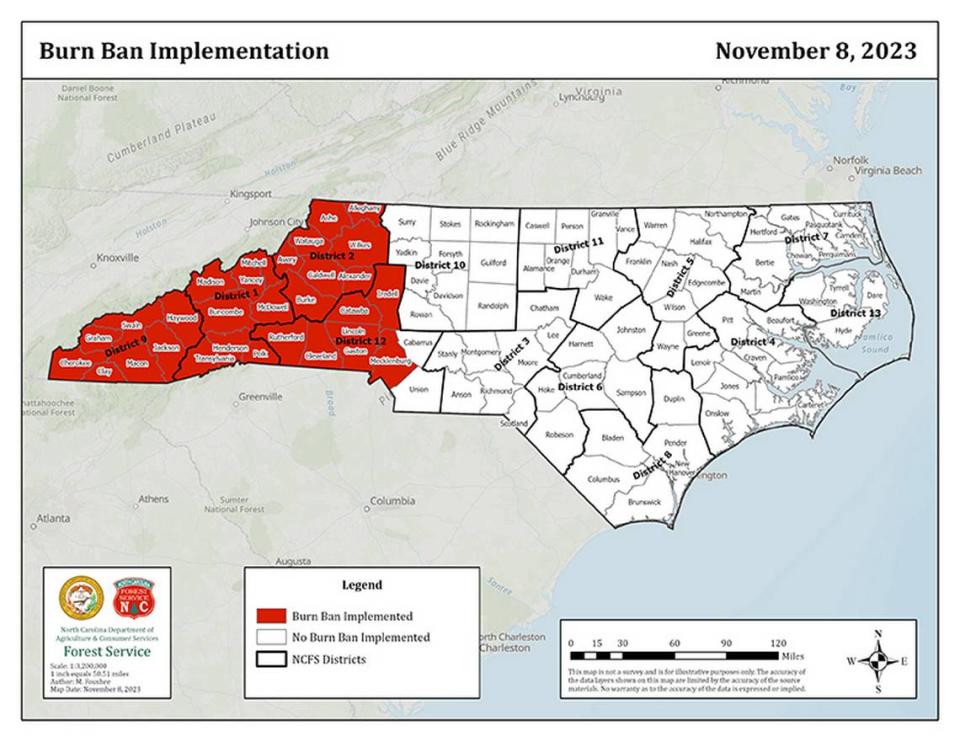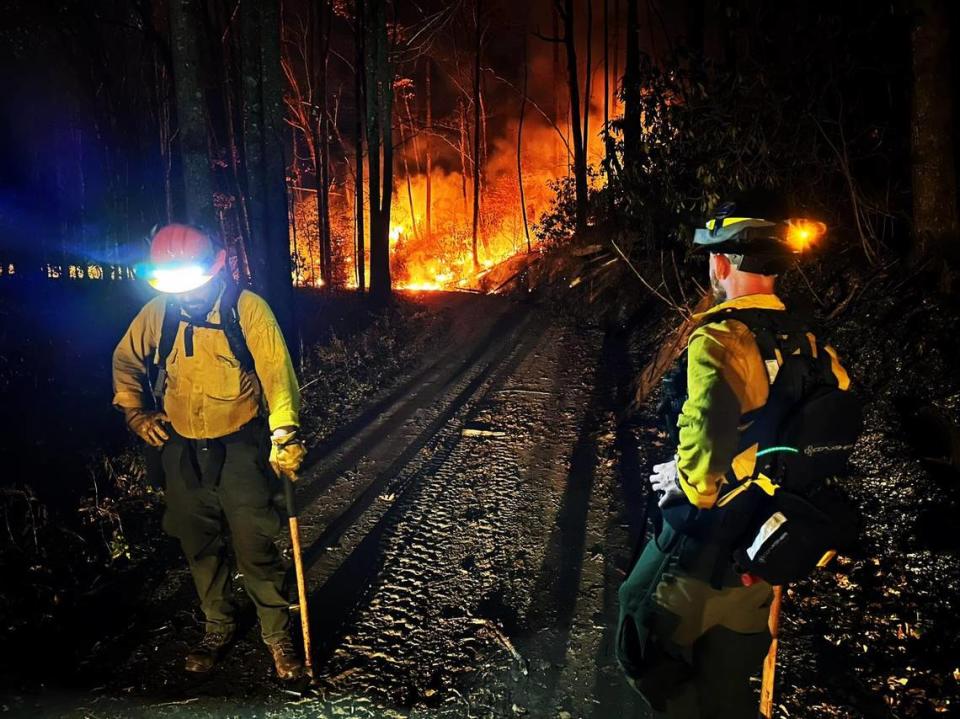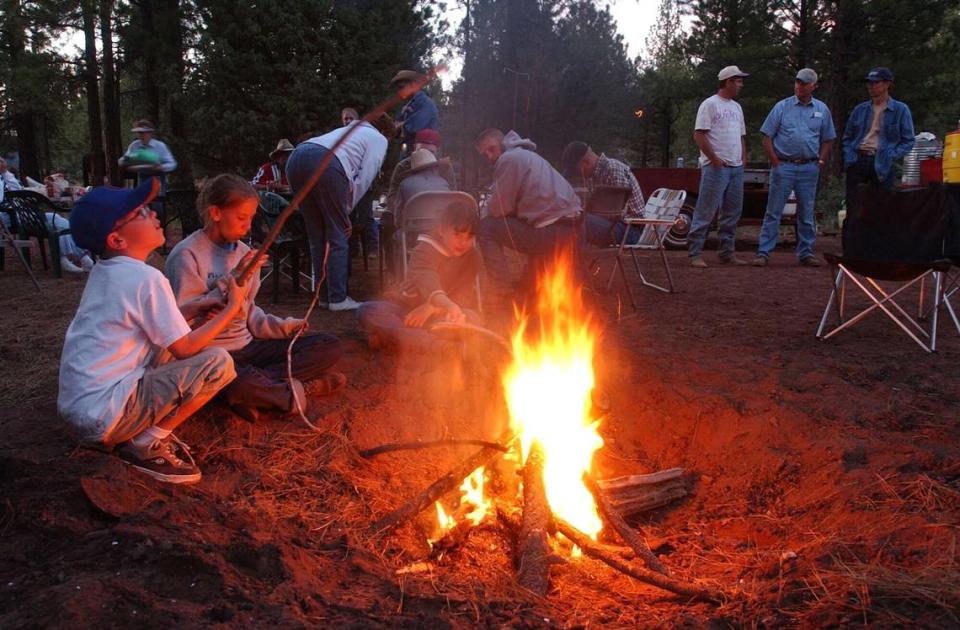30 NC counties are currently under a burn ban. Updated map shows restricted areas
- Oops!Something went wrong.Please try again later.
The state Forest Service has banned outdoor burning in 30 Western North Carolina counties in the wake of a spate of wildfires that have burned thousands of bone-dry acres.
Gov. Roy Cooper has declared a state of emergency in 33 western counties so state officials can mobilize resources if necessary.
What prompted the ban?
A lack of rainfall over much of the state, most acute in western counties, combined with warm temperatures and low humidity have made conditions ripe for wildfires. Half of the state is currently in a drought.
Thursday, the N.C. Forest Service was working at least eight active wildfires in the state, six of them in western counties plus one in Alamance and one in Wayne.
The biggest blaze Thursday was the Collett Ridge Fire in the Nantahala National Forest about 4 miles outside the town of Andrews, in the far western corner of the state, where firefighters have been struggling to keep the fire from spreading. That fire was at 4,372 acres Thursday morning and expected to continue to spread.
Officials hope that rain from an incoming cold front will help with containment efforts Friday.
Is any burning allowed?
Under the ban, which was issued in two parts with 14 counties covered Sunday night and 16 more added Wednesday:
All open burning is prohibited.
All burn permits previously issued are canceled.
No new permits will be issued until the ban is lifted.
Open burning includes burning leaves, branches or other plant material as well as trash, lumber, tires, newspapers and other materials.
Anyone violating the burn ban can be cited and fined $100 plus $183 court costs. Anyone found responsible for starting a fire could be held responsible for the cost of extinguishing it.
Unless a town or county ordinance prohibits its, use of a grill for cooking is allowed.
The N.C. Forest Service’s ban doesn’t apply to burning within 100 feet of an occupied dwelling, where county fire marshals have jurisdiction. The Forest Service has asked the 30 counties to consider banning open burning within 100 feet of dwellings.

Which counties have burn bans?
Alexander
Alleghany
Ashe
Avery
Buncombe
Burke
Caldwell
Catawba
Cherokee
Clay
Cleveland
Gaston
Graham
Haywood
Henderson
Iredell
Jackson
Lincoln
Macon
Madison
McDowell
Mecklenburg
Mitchell
Polk
Rutherford
Swain
Transylvania
Watauga
Wilkes
Yancey
What’s banned in national forests within North Carolina?
The governor’s state of emergency covers Alexander, Alleghany, Ashe, Avery, Buncombe, Burke, Cabarrus, Caldwell, Catawba, Cherokee, Clay, Cleveland, Gaston, Graham, Haywood, Henderson, Iredell, Jackson, Lincoln, Macon, Madison, McDowell, Mecklenburg, Mitchell, Polk, Rowan, Rutherford, Swain, Transylvania, Union, Watauga, Wilkes and Yancey counties, as well as tribal lands of the Eastern Band of the Cherokee Indians.
Inside that area lie the Pisgah and Nantahala National Forests, where:
▪ No fires are allowed outside developed recreation sites.
▪ No fireworks or other pyrotechnic devices are allowed.
▪ Campfires are allowed only inside the metal fire pits the forest service provides at campgrounds that have camp hosts: Balsam Lake Lodge, Curtis Creek Campground, Davidson River Campground, Kimsey Creek Group Camp, Lake Powhatan Campground, North Mills River Campground, Sunburst Campground, Standing Indian Campground, and Wolf Ford Horsecamp.
▪ Campers are allowed to use portable gas camp stoves and grills.

What’s allowed and what is banned in state parks?
Also in the affected area are 13 state parks where all open fires – including campfires – are prohibited until further notice. The parks are:
Chimney Rock State Park
Crowders Mountain State Park
Elk Knob State Park
Gorges State Park
Grandfather Mountain State Park
Lake James State Park
Lake Norman State Park
Mount Jefferson State Natural Area
Mount Mitchell State Park
New River State Park
Rendezvous Mountain
South Mountains State Park
Stone Mountain State Park
▪ Campers are allowed to use portable gas stoves for cooking, and may use charcoal grills if no local ordinances prohibit their use. Individual parks will know whether local governments have instituted their own burning bans.
▪ If using a charcoal grill, campers should pour water to thoroughly soak the briquettes after use, stir the coals and pour additional water to ensure all embers are extinguished. Coals should not be buried.
▪ Stoves and grills must never be left unattended.


